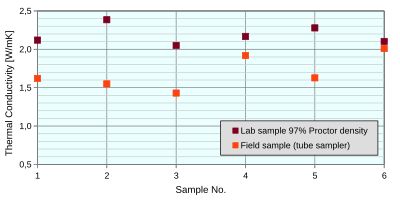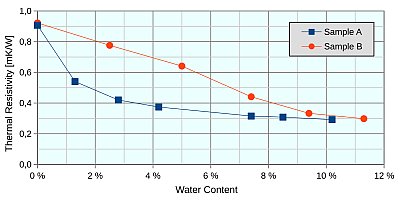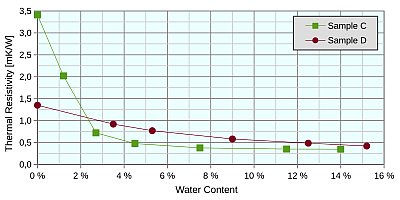Backfill Materials
Cable trenches and geothermal installations usually require backfills with low thermal resistivity / high thermal conductivity. Like sand and soil in general, backfills consist of solid grains (matrix) and pore volume. A good backfill is characterized by a high matrix thermal conductivity and a low pore volume (i.e. a high degree of compaction). Thermal conductivity tests help to select an appropriate material for your application.
![arrow]() Material Composition
Material Composition
The matrix thermal conductivity of natural materials covers a range of approx. 0.5 to 12.5 W/mK, with pure quartz sand showing the highest values. Additives like cement or bentonite can increase the density, but not necessarily the thermal conductivity, because their matrix thermal conductivity is lower than that of quartz sand. Thermal conductivity tests help to decide if additives make sense for a particular application.
![arrow]() Grain Size Distribution and Compaction
Grain Size Distribution and Compaction
 Materials with a wide grain size distribution compact well, resulting in a small pore volume and low thermal resistivity values. Fine grained materials lacking coarse components and coarse sands without finer grains will not reach high thermal conductivity values. If no suitable backfill is available, mixing a fine grained with a coarse grained sand may improve the thermal properties.
Materials with a wide grain size distribution compact well, resulting in a small pore volume and low thermal resistivity values. Fine grained materials lacking coarse components and coarse sands without finer grains will not reach high thermal conductivity values. If no suitable backfill is available, mixing a fine grained with a coarse grained sand may improve the thermal properties.
![arrow]() Water Content
Water Content
 The thermal resistivity of sand and soil decreases with increasing water content. Backfills should have a low thermal resistivity, so a dried sample represents the worst case. To compare different materials, it is useful to test a saturated sample (the best case) as well.
The thermal resistivity of sand and soil decreases with increasing water content. Backfills should have a low thermal resistivity, so a dried sample represents the worst case. To compare different materials, it is useful to test a saturated sample (the best case) as well.
The correlation between water content and thermal resistivity of sand and soil is non-linear, which means that two materials can have the same thermal resistivity in the saturated and in the dried state, but perform differently at intermediate water contents typically found in the field.
Dry-Out Curves
 A dry-out curve covers a material's entire thermal resistivity range: A saturated sample is dried in 5-10 steps until the weight becomes constant. The thermal resistivity is determined in each of these steps and plotted versus the water content.
A dry-out curve covers a material's entire thermal resistivity range: A saturated sample is dried in 5-10 steps until the weight becomes constant. The thermal resistivity is determined in each of these steps and plotted versus the water content.
Our Services
We provide measurements at any desired water content (dry, saturated, field moisture) or complete dry-out curves. Results are reported as thermal conductivities in W/mK or thermal resistivities in mK/W.


